Where do webinars fit in the video marketing landscape? Does it make any sense to invest in long-form video content? What are the leading purposes of organizing webinars? Yes, our yearly State of Webinars 2020 is here! Let us walk you through our complete webinar report and discover how you can embed those insights into your digital business roadmap.
Last year, we opened our webinar report with a provocative question – are webinars dead? Going through the data collected by ClickMeeting, and findings from external, reputable sources, we proved that webinars are far from being extinct.
On the contrary, it turned out that they still prove its worth in delivering sales and marketing results, especially in the B2B ecosystem.
But it was last year. You know perfectly well that:
-
Technology keeps on accelerating, bringing new tools and solutions to the table;
-
Customers’ keep on evolving, and it’s getting more challenging to come and make them stay with you for longer;
-
Brands need to adapt and reshape their communication
So, how did video marketing and webinars find their place in the shifting digital landscape?
Table of Contents
State of Webinars 2020 – webinar report
Like a year and two years ago, we now have a pleasure to present to you the State of Webinars 2020 infographic, packed with statistics and insights, brought to you by the ClickMeeting team.
Further on, we will put them into a business perspective and check if they come in line with other marketing reports and forecasts.
Are you ready to dive in?

Webinar landscape in numbers
Let’s take a look at webinar reality from a bird’s eye view. We analyzed our data carefully and wanted to summarize all the online events held on the ClickMeeting webinar platform in 2019.
It turns out that companies all over the world hosted exactly 627,033 events. Comparing to last year’s finding, 604,488 events hosted in 2018, we can dare to state that webinars are still on the rise.
But there’s more – those live, automated, and on-demand webinars have gathered an overall audience of 8,504,770 unique attendees!
For how long does the audience stay in the webinar room?
Another striking metric was the average time duration of a webinar in 2019. As you might spot it in the infographic, we are talking about 84 minutes!
Yes, an hour and 24 minutes of uninterrupted online broadcasting. And that’s an AVERAGE! So, taking into account that among 627,033 events, there were also shorter team meetings, which means that, in many cases, time duration could have been much longer than 84 minutes.
OK, but you might think – “just because some marketers didn’t know when to stop broadcasting and pursued to bore their audience to death, it doesn’t mean that their attendees managed to stay with them till the end.”
Dwell-time goes up!
That’s a good point, but we have thought of that earlier and double-checked it. And the result was even better than 12 months ago – the average time spent on watching a webinar is 53 minutes!
Last year it was 52 minutes! It made us excited because this figure proved that people are in demand for long-form, in-depth content delivered through web conferencing.
Right now, we are facing an average time (!) of 53 minutes spent on the consumption of the webinar content. And while marketers bitterly admit that people are skimming the text instead of reading it (a heartbreaking TLDR acronym), this impatient attitude doesn’t apply to watch webinars!
What does it mean for you as a marketer or as a brand? If you have much to communicate, webinars are the way to go.
Money-making machinery
One of this years’ report’s highlights is the amount of money earned from a single webinar. Since we launched the paid webinars feature back in 2018, there is no more straightforward and more direct way to generate income through webinars.
Many companies and solopreneurs seized that opportunity and decided to capitalize on their specific know-how and expertise by selling tickets to their online events.
Only last year, all paid webinars hosted on the ClickMeeting webinar platform have generated a total of $366,000.

The most successful webinar host earned $20,930 on a particular event! It didn’t break the last year’s record (which was $43,000), but hey – wouldn’t it be sweet to make $20K from just one webinar?
What’s the point of running webinars?
Yes, the purpose, the big WHY. What are the reasons to invest time and money in organizing online events? We have analyzed hundreds of webinars to categorize them and look for a pattern. Here’s what we came up with:
The purpose of organizing webinars:
- Online courses and training sessions – 35,6% (and 25% of which strictly refers to internal training activities);
- Product demos and marketing – 27,8%;
- Online business meetings – 11%;
- Beliefs and esoterics – 2,7%;
- Other – 22%.
Now, even though religious and esoteric online events might be exciting in terms of social science, we’re not going to concentrate on them. We will also skip the Other category because of its randomness.
Instead, let’s break down the sharp categories:
Online courses – teach and train through webinars
There are two subcategories here: online courses, which reflect the phenomenon of e-learning and online teaching, and training sessions, more technical activities, strongly related to corporate onboarding and knowledge sharing.
Create a virtual classroom
Let’s start with online courses. Webinars are a fully equipped digital tool to create virtual classrooms and lecture rooms and to reach out to students all over the globe.
Arturo Tedeschi, a world-class computational designer, is a vivid example of how to convert traditional teaching actions to running online courses with webinars:
Webinars improve the engagement with people, so my community is growing thanks to webinars, and this is important for my next steps in online teaching. I’m convinced that webinars are the future of education since you can reach many people all over the world with a simple and reliable platform – Arturo admits.
Onboarding and training, on the other hand, gather a different audience. The target is not online students and hungry for knowledge professionals. Instead, this solution is dedicated for corporate employees or franchisees.
No more offline training events
Let’s bring Nest Bank as an example. Thanks to employing webinars into their internal communication, they have managed to dramatically reduce time and costs wasted on old-school training events held in the field. Instead of hitting the road each time to meet with team members scattered all over the country, they can gather them all up in one virtual conference room:
Today, if we had to come back to stationary training events, we would have to organize 16 long sessions in 16 different regions. It would take ten times longer to achieve it, not even mentioning the travel costs, venues, accommodations, and so on – said Krzysztof Grodecki from Nest Bank. – Instead of wasting two weeks of our time, we spend only one day to do all of this with a single webinar!
What are the real-life examples of webinars within the training and online courses category? Here you go:
Online courses:
- Game development workshop;
- Coaching certification program;
- JAVA programming (basics course);
- Start your trading career (lesson 1);
- Forex professional trading (the basics);
- BEC Certificate in English Pronunciation;
- Tableau data analyst/developer class;
- Postgraduate studies – real estate appraisal.
Training sessions:
- Company system onboarding training;
- New employee onboarding;
- Sales representatives webinar;
- Why we need customer feedback;
- Employee assistance program;
- Do’s & don’ts on an introductory call;
- Marketing declarations for cosmetic products;
- Grant writing for nonprofit professionals.
Marketing and product demos – inspire and sell with webinars
Like above, we have merged two subcategories: marketing webinars – lead generation, inspirational and knowledge-sharing events, and product demos – live demonstrations of products that have one ultimate purpose – to redirect leads to a landing page with a buy-now or a sign-up form.
Marketers and salespeople fell in love with webinars, and we will prove that statement later on with some powerful takeaways from meaningful reports.
Those two subcategories are here together because there is no longer a point for today’s sales and marketing departments to compete with each other. Moreover, in the case of smaller companies or individuals running their business as lone rangers, marketing and sales are as close as only two people could be.
Knowledge sharing is the key
Webinars, with all their interactive nature, also tune into the latest trend – conversational marketing. But most importantly, this video marketing format is here for something crucial – sharing knowledge
Let’s give it to Karolina Matyska, Content Manager at Senuto:
It’s great to hear that our customers want the knowledge that we share and look forward to getting it. What is more, they want to know whether they can get notified about the newest webinars.
So, what are the real-life examples of webinars within the marketing and product demos category?
- E-learning platform (demonstration);
- Getting started with CRM;
- Free demo language lesson;
- Secondary software introduction webinar;
- New offer & products for 2019;
- Basic parametrization of frequency converters;
- Laser beam shaping and modulation;
- Passive house – it works!
Online business meetings – the future of work is now
There is an array of exciting scenarios falling into this category! The explosion of video conferencing, project management, product development, or team collaboration applications didn’t come out of anywhere.
The demand for these apps will keep on rising because of digital business dynamics. Corporations with branches scattered all over the world, companies that need to hire offshore software development teams, outsourcing graphic designers, copywriters, SEO experts – it’s a reality that will only get reinforced.
Not to mention companies that entirely rely on telecommuting and remote work. Video conferencing and online business meetings are their daily bread.
Online business meetings not only serve perfectly for managing remote teams, and to catch C-level execs who are always on the move, but also empower account managers and business developers to reach out to leads and customers regardless of a continent they live in.
Pitch your investors no matter where they are
For Studio Filmowe Panika, a movie production studio from Poland, online meetings turned to be a stunningly effective way to pitch potential shareholders:
90% of conversion is so out of this world!
What are the real-life examples of webinars within the online business meetings category?
- Salary planning;
- Board meeting;
- Quarterly meeting;
- Finance committee meeting;
- Team meeting;
- Project scope overview;
- Leaders briefing;
- Project status & report.
Top webinar features
Since we know the scale and the purposes, it’s time to take a look at the webinar toolkit. We have analyzed how many times each ClickMeeting feature was used.
Because some of the features are relatively new (for instance, automatic follow-ups entered the game in the middle of 2019), we divided the ranking into two groups: the most popular (classic) features and the rising stars.
The most popular webinar features:
-
Presentation – the classic. Playing a slideshow is still the heart of most of the webinars out there.
-
Screen sharing – we can’t imagine running online courses, sales and marketing webinars, or team collaboration meetings without an option to demonstrate what’s happening on the presenter’s screen. An absolute must-have for all product demos events.
-
Q&A mode – Q&A tool came in third, and it doesn’t surprise us. This stage comes right after the presentation, and it gives you a chance to clear all doubts and to interact with your audience.
-
YouTube – this one refers to playing a video clip from the YouTube platform within your webinar room. A great way to inject some entertainment in the middle of presenting a complex subject.
-
Whiteboard with drawing tools comes in handy for online trainers and teachers who draw illustrations to visualize a complicated aspect of their lesson or course.
-
Call-To-Action – we expected to see this one higher in the ranking, but the 6th position is still stable. Adding a customizable CTA button is not optional if you seriously think of selling your products with webinars.
-
Live streaming on Facebook or YouTube – no wonder this integration is so commonly used. It’s an option to broadcast your content in the webinar room and, at the same time, stream it live on either Facebook or YouTube.
-
Surveys close the top eight of the ranking. Achieving remarkable sales results involves knowing your target attendees inside out. What could have been more useful for this than asking important questions once you have their full attention during a webinar?
The rising stars:
-
Unsplash photos – deployed at the beginning of 2019 and became a part of the Custom Branding feature. Choose a stunning and professional photo (and a one that matches your business niche or a webinar topic) from the Unsplash base and set it as a background to all your webinar pages.
-
YouTube / Facebook auto streams – one of the webinar automation features released in the middle of last year. It’s not surprising that it catches attention – broadcasting webinars on Facebook or YouTube can happen automatically.
-
Follow-up e-mails – presenting webinar content is one thing. But encouraging your audience to take action (sing up for a course, create a free trial account on your platform, buy your product – you name it!) can also take place outside the webinar room. That’s why automatic follow-up e-mails entered the stage.
-
Automatic invitations to upcoming events – if you plan your webinar activities, you can automate a set of actions to achieve more: keep your video conferencing machine going and save your time.
-
Feedback button – this little trick is getting more and more popular among the presenters. It’s a simple way to check whether you have impressed your audience or not.
-
Thank-you e-mail with webinar recording – this automation tool is super useful, especially for online teachers or trainers who share (or sell) precious knowledge during their events. With this feature, attendees receive an e-mail with the webinar recording after the event is over.
-
Certificate of attendance – like above, this tool was designed for online teachers, and they quickly put it to action. Each person who attends an online course receives a certificate as a good-looking proof of acquired knowledge. A win-win situation for a teacher and a student!
What is the best time to host a webinar?
In February 2019, Brian Dean, together with BuzzSumo, revealed the results of a vast content study stating that, after analyzing 912 million blog posts (!), there is no such thing as the best day to publish an article on a blog.
When it comes to webinars, however, there’s a market trend to broadcast webinars on Tuesdays. We ran into the same finding last year, and right now, we’re facing the same fact – Tuesday is a webinar day!
And what about an hour? What’s the most popular time of the day to start streaming your content? Here are the top three hours:
- 4:00 PM;
- 3:00 PM;
- 2:00 PM.
Desktop or mobile – how do people join webinars?
A statement that we’re living in the golden age of mobile has become a digital mantra. With professionals and students who are on the move most of the time, it might seem logical that people would rather join the webinar room through their smartphones.
It might surprise you, but computers are still winning this race. We’ve checked it, and it looks like the mobile supremacy is yet to come. At least for the webinars.
The ways to join a webinar when it comes to a device:
- Desktop: 68,39%
- Android: 20,91%
- iOS: 10,69%
- Other: 0,02%
However, it doesn’t mean you can neglect the mobile users. They make up 1/3 of the overall webinar audience. So, make sure that joining your event from a smartphone is as seamless as possible.
Webinars in global marketing trends for 2020
So far, we have deciphered all the data concerning webinars held on ClickMeeting in 2019. What we’re going to do right now is to put it into a broader perspective.
The beginning of each new year delivers dozens of reports, predictions, forecasts, and studies. It’s no different when it comes to digital marketing. We have analyzed the most reputable and valuable ones to deliver you the essence.
And most importantly – we wanted to find a link between the latest trends, good practices and running webinars for you.
Keep your finger on the (marketing) pulse
Publishers in the marketing field worship particular trends and technologies that will disrupt marketing in 2020. They juggle with augmented and virtual reality, AI-based automation, conversational marketing, personalized and visual content, focusing on customer experience, data protection, or SEO in terms of voice search.
All of those aspects deserve appropriate attention, but you can recognize a pattern here. To focus on your customers’ experience, you need to fall into a line to conduct a dialogue with your audience. It’s no longer about highlighting your brand values and product features.
There has to be a mindset change towards fulfilling customers’ needs in nanoseconds. They demand answers to their problems, and they expect to get them fast.
Moreover, with the brand-agnostic approach, customers require a highly personalized content tailored for their specific needs. Otherwise, they will be bouncing from your website, just like that!
But most importantly, the content needs to be visual. It might be disheartening if writing is your super-power, but it’s true – people prefer visual content. Quoting after the Venngage:
“People are visually-oriented: 90% of information transmitted to our brain is visual, presentations with visuals are 43% more persuasive, and 65% of us are visual learners.”
The (video) king does not even think of abdicating
What all marketing virtuosos agree on is the dominion of video marketing. And it makes total sense considering the personalized and visual content.
Every year, people spend more and more time consuming online video and marketing departments seize the opportunity and keep on allocating more budget on online video ads. Video is the emperor, and that’s not going to change anytime soon.
What kind of video content companies tend to produce? The short pieces, under five minutes. Why? Because marketers are enslaved to thinking about a short attention span.
Here’s what Smart Insights published:
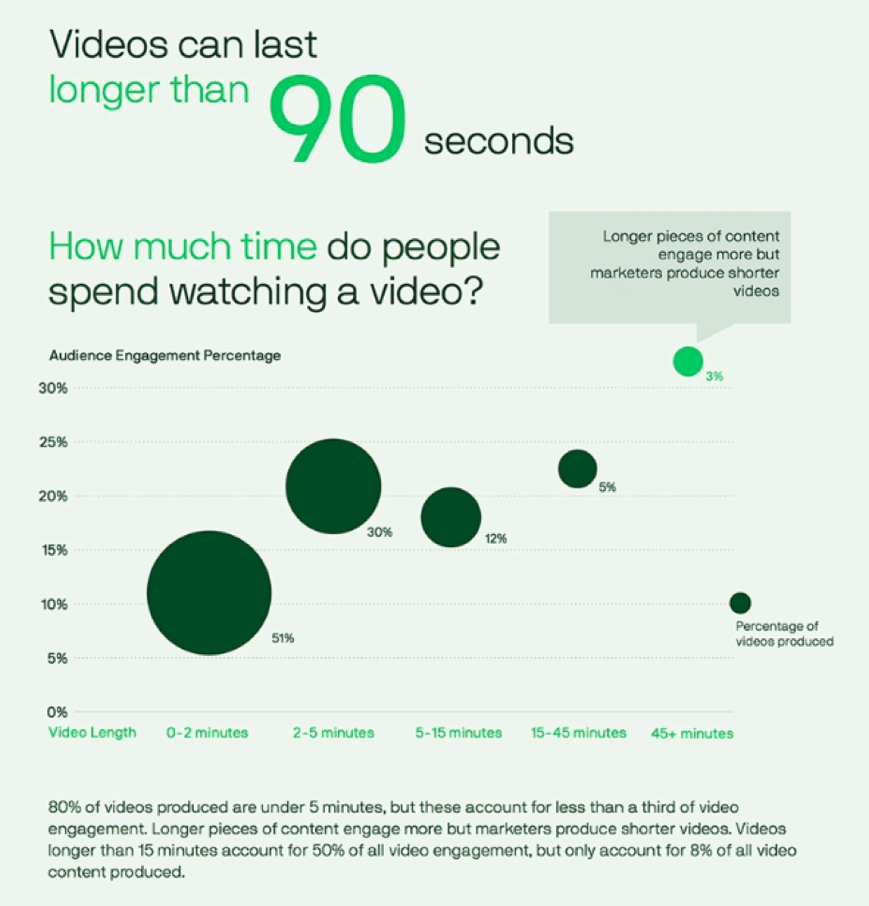
The majority of video content materials are short, BUT it’s the 45 minutes+ video content that moves the needle and generates the highest engagement from the audience!
What video formats do the trick?
How can you set video content in motion? According to HubSpot, there are 12 types of marketing videos:
- Demo videos;
- Brand videos;
- Event videos;
- Expert interviews;
- Educational and How-to videos;
- Explainer videos;
- Animated videos;
- Case study and customer testimonial videos;
- Live videos;
- 360° & virtual reality videos;
- Augmented reality (AR) videos;
- Personalized messages.
Everything seems to be exciting. To help you in choosing the best video format, we asked thriving video practitioners.
Bobby Umar, five-time TEDx speaker who runs LinkedIn Live video daily (seriously – each day we receive a push notification that he’s going live on LinkedIn), said to us:
Live streaming offers the best accessibility, interaction, and return on relationships. But short live videos are great for sharing that one great nugget. Longer video formats, on the other hand, are best for training purposes.
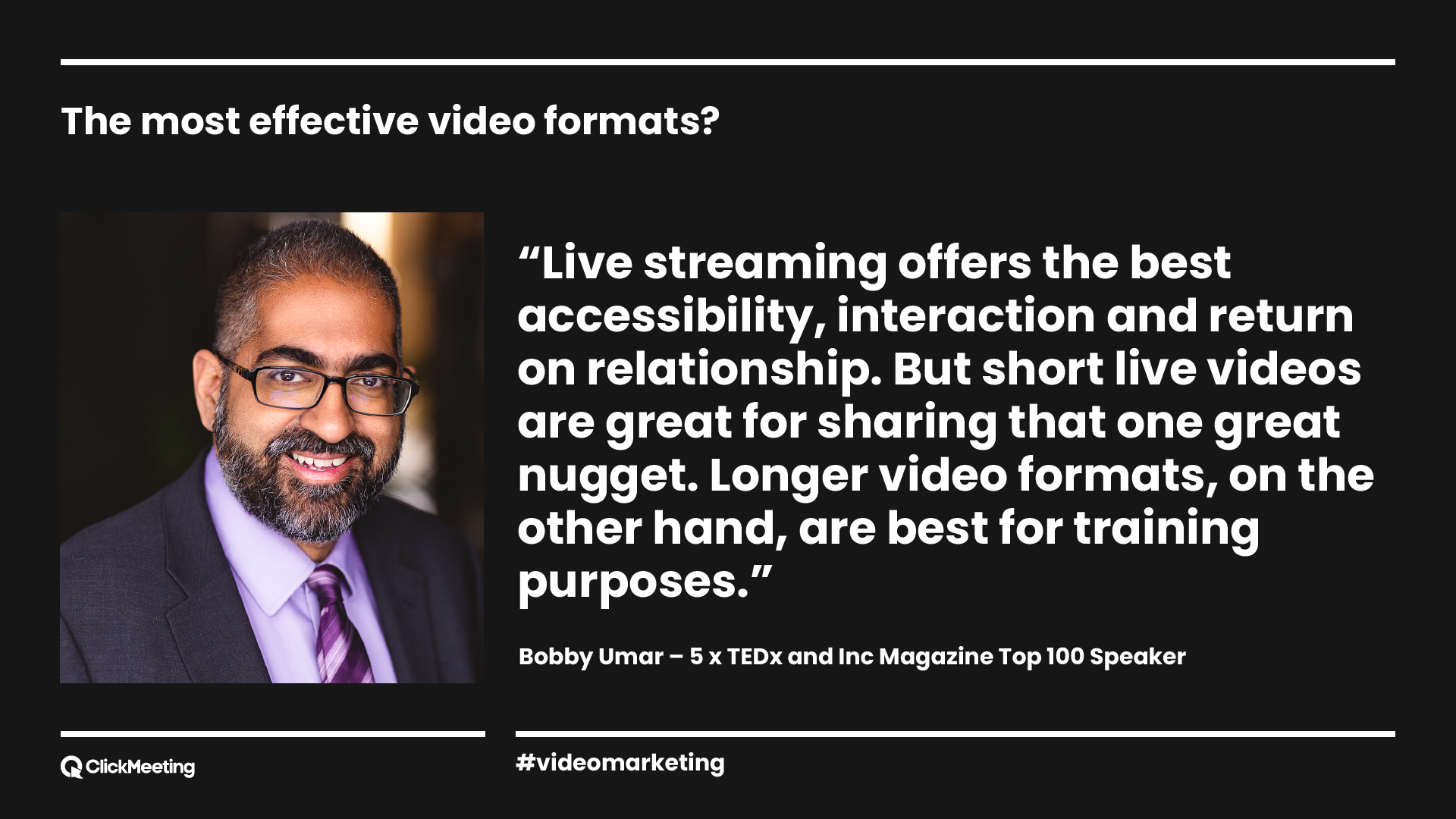
Brian Dean, the founder of Backlinko, an SEO expert, and one of the most influential content marketers in the world, shared with us his opinion about the most effective video formats:
It depends on the goal. If the goal is to reach the most amount of people, YouTube videos are #1 by a mile. There’s no other platform that can get your videos in front of most people. If your goal is to engage with your existing followers, live videos work best because they have that interactive element. And if your goal is to educate and sell, webinars are the way to go.
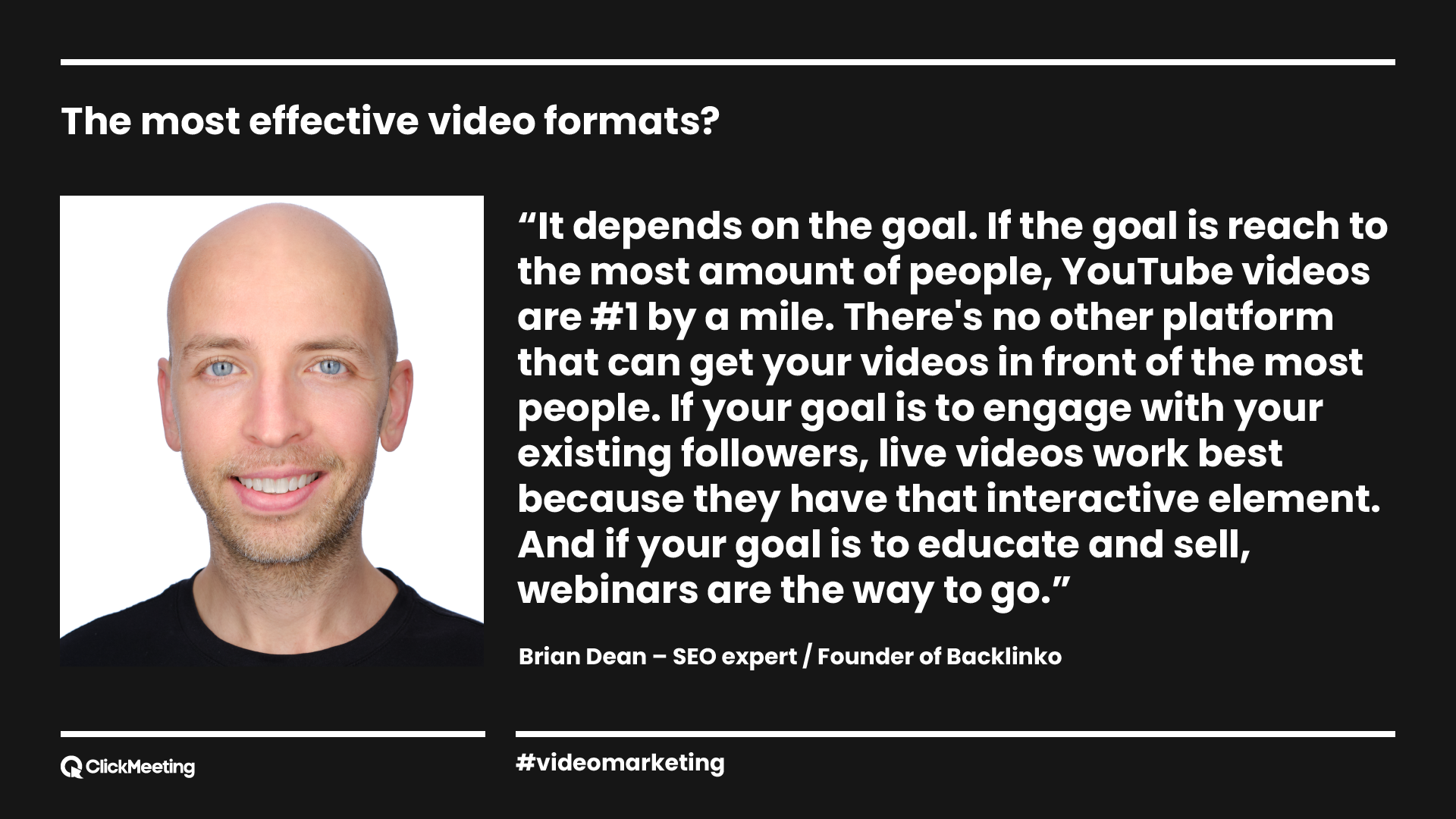
Video – how does it serve?
We’ve been waiting impatiently for the Wyzowl’s Video Marketing Statistics 2020 report (it’s a gated content, but you don’t want to miss that) as it has brilliantly put video marketing into the digital business perspective in the last year.
Here are some highlights from Wyzowl’s report. Let’s start with the WHY. What is the reason marketers are bond to video?
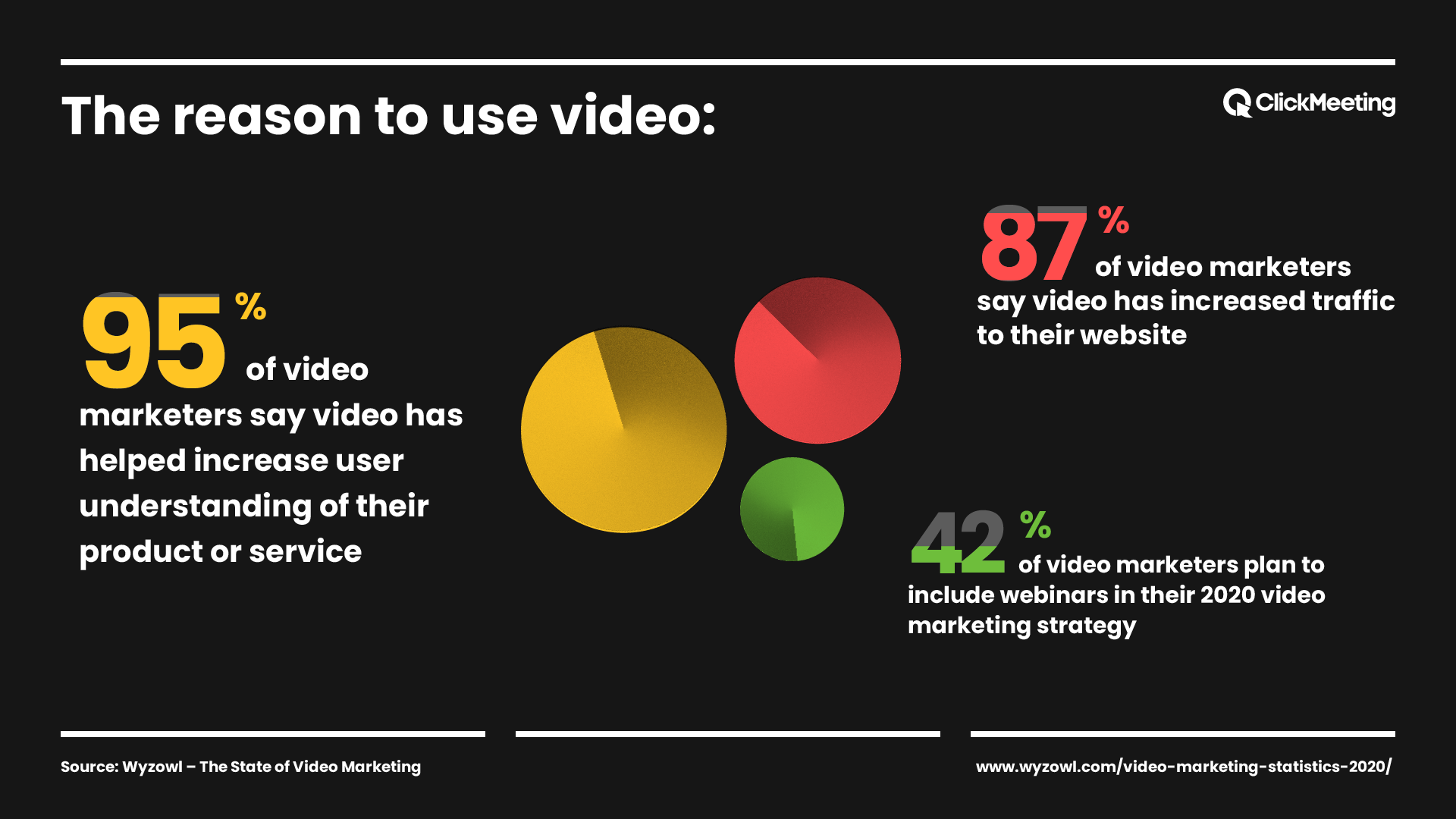
As you can see, the vast majority of marketers interviewed by Wyzowl, confirmed that video brought them substantial results – more website traffic and a better understanding of their product or service.
If one of the core reasons is user understanding of a product, there’s no wonder that 42% of marketers are positive about using webinars in 2020. Getting back to our data, product demos, and marketing webinars are nearly one-third of all online events held on ClickMeeting.
Now, let’s take a look at how marketers choose video formats:
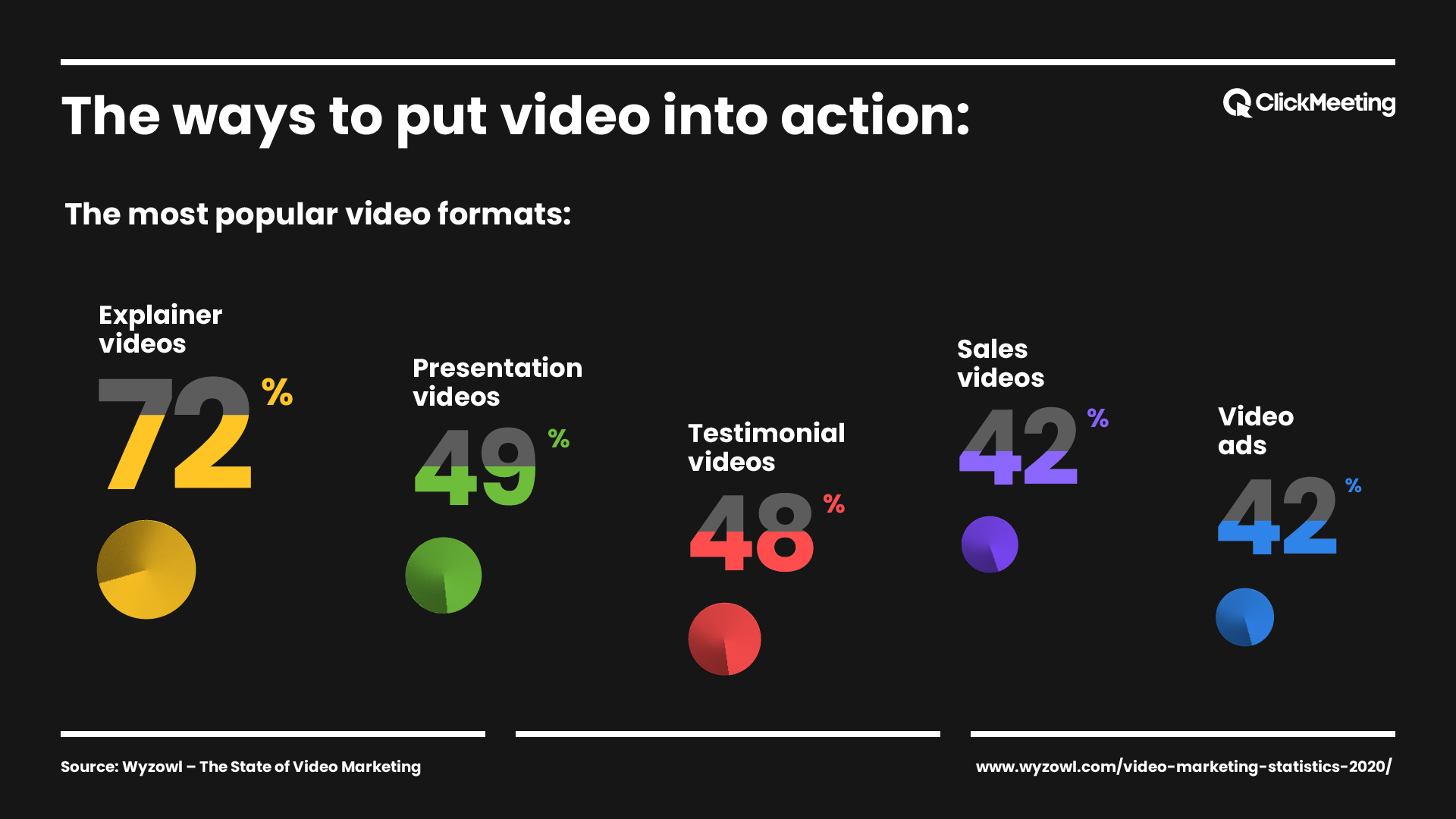
Again, it makes absolute sense. Apart from video ads and testimonial videos, the rest of the formats beautifully correspond with webinars.
But enough of the marketers’ perspective for a moment. Let’s take a look at it from a different angle – what impact does video make on consumers?
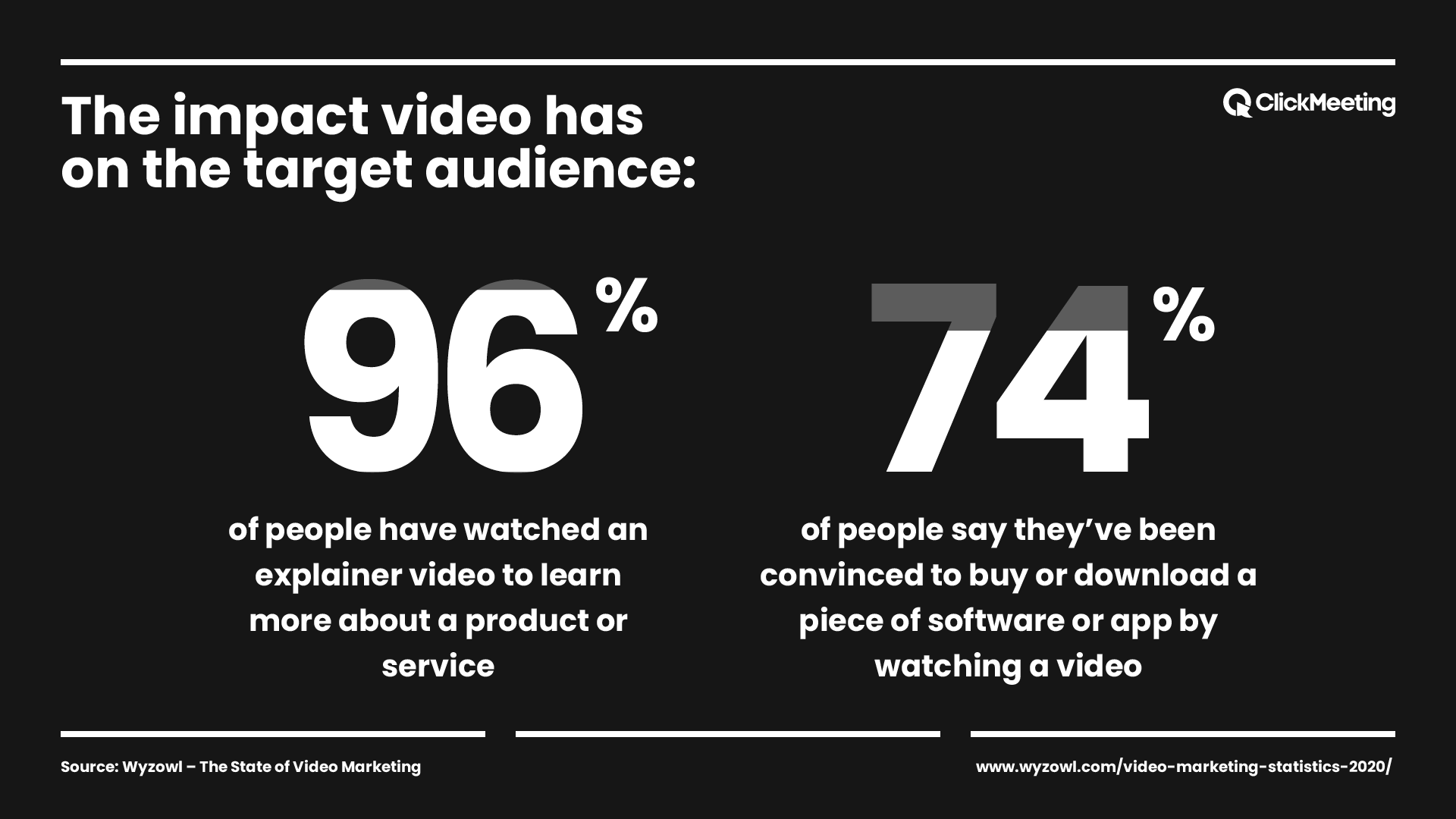
Impressive! Those findings confirm the power of product demos, especially in terms of selling software. So, if you’re into SaaS sales and marketing, the best way to sell your app is to explain how it works. And webinars are packed with tools to make that happen.
Webinars meet the funnel
The second report we were eager to get our hands on, is the Demand Generation Benchmark Study: Quality Over Quantity Takes Center Stage for Demand Marketers. This insight-heavy report was brought to you by Demand Gen Report.
Now, although some publishers pronounced funnel’s death, it remains for plenty of companies as a default structure for sales and marketing activities.
The Demand Generation Benchmark Study is a must-read, and it deserves a separate overview, but in terms of our webinar report, two outcomes match webinars with the funnel:
Webinars at the top of the funnel:
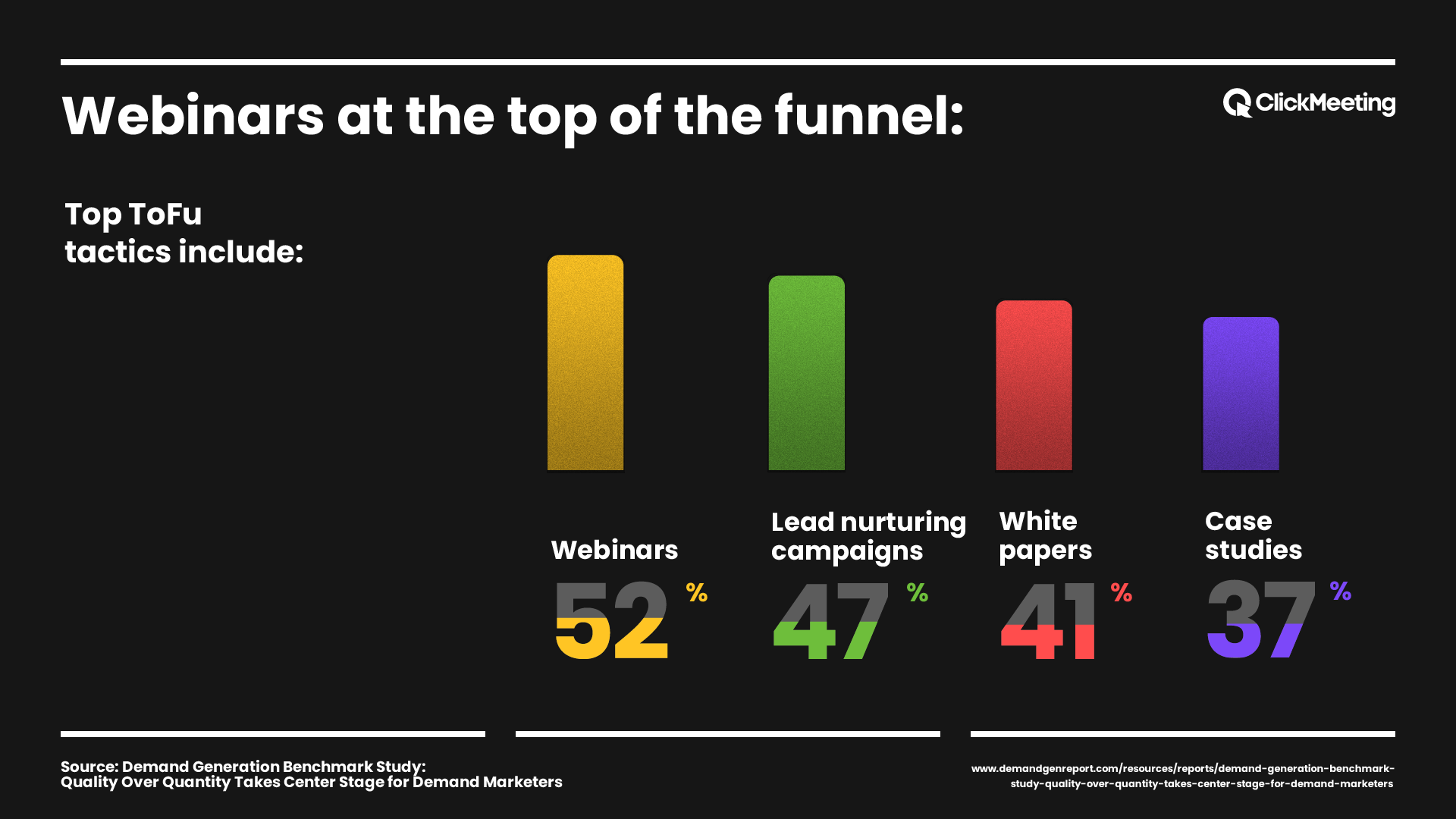
Webinars further down the funnel:
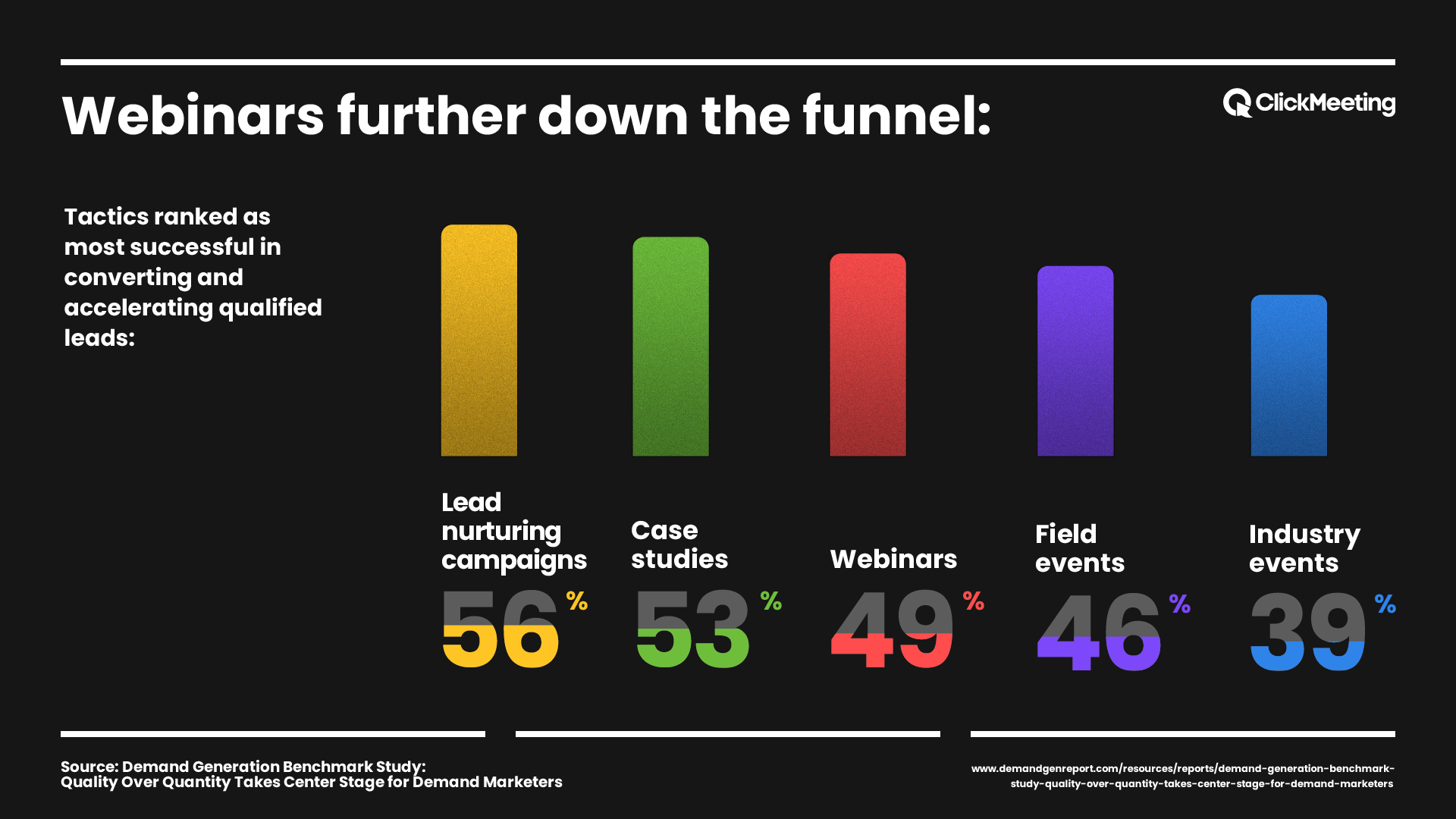
As you can see, webinars, together with lead generation campaigns and case studies, prove their worth in both – ToFu (top of the funnel) and BoFu (bottom of the funnel).
Previously quoted TEDx speaker, Bobby Umar, agrees with that observation:
Webinars are an excellent lead gen tool, a great way to deliver content and value for your audience. They are the type of content that starts future conversations for your work or packages. Even better when you can automate them to scale.
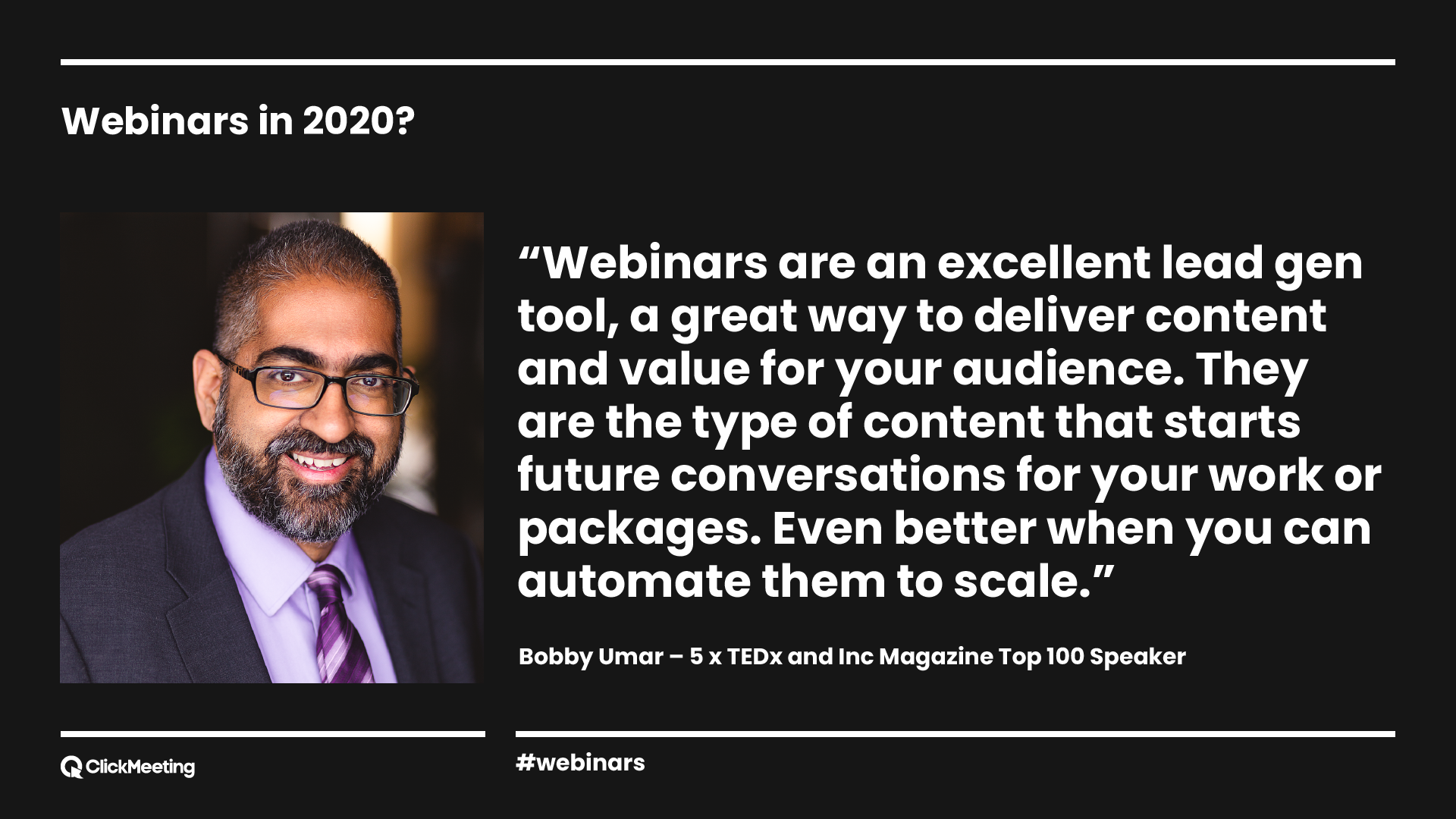
Webinars in 2020
However, we have come across some opinions that webinars are not a hot subject nor a trend to rely on in the nearest future.
Our data gathered in the ClickMeeting headquarters, studies conducted by Wyzowl and Demand Gen Report, say otherwise.
And so does Backlinko’s founder – Brian Dean:
I think webinars still have their place. I know a few folks personally who are crushing it with webinars right now. But for them to work in 2020, they can’t just be the “30 minutes of fluff followed by a hard sell” webinars that many people still use. The ratio needs to be more like 80% value and 20% pitch.
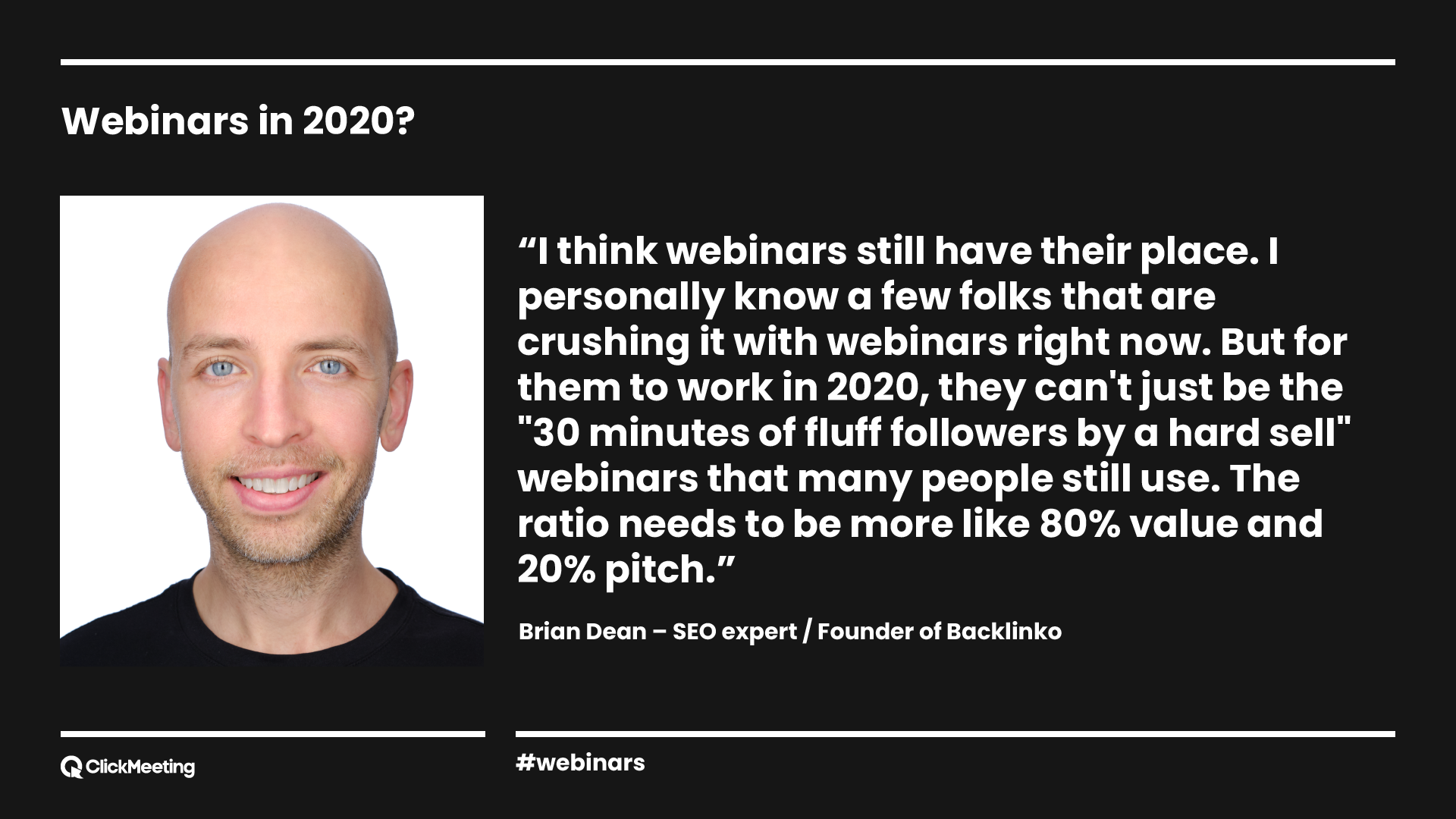
Are you ready to tune into those video marketing trends?
That was quite a journey! We have delivered and interpreted tons of ClickMeeting data for you, to show you how businesses all around the world employ video conferencing, online business meetings, and long-form webinars into their marketing, sales, and education strategies.
There wasn’t a better time to put webinars into play. Especially, with all the automation tools at your fingertips, empowering you to scale up your results and reinvest your time spent on repetitive and mundane work.
So, are you in? Sign up for a 14-day free trial today and start broadcasting your content!








